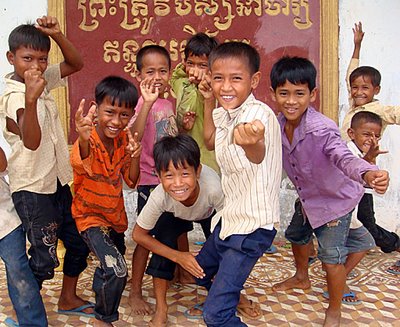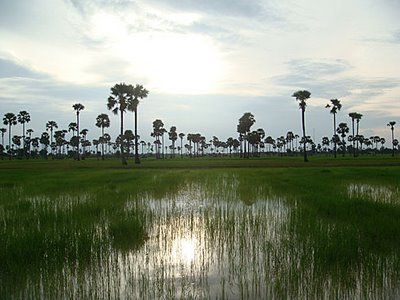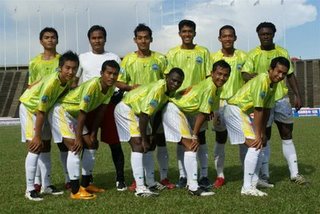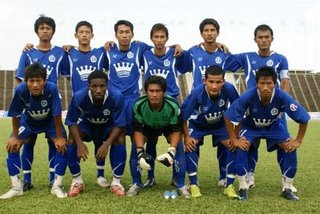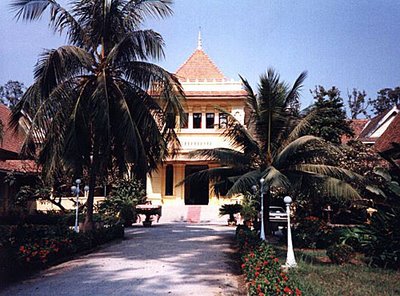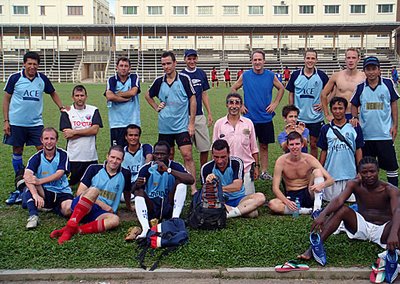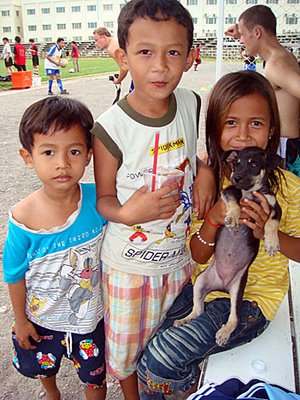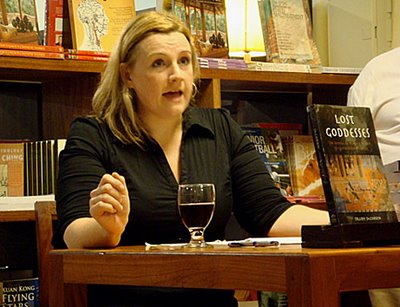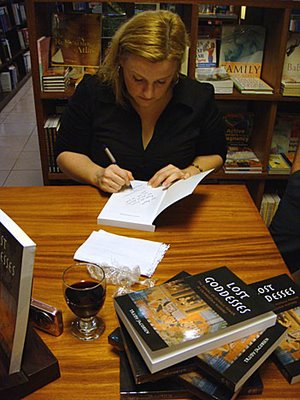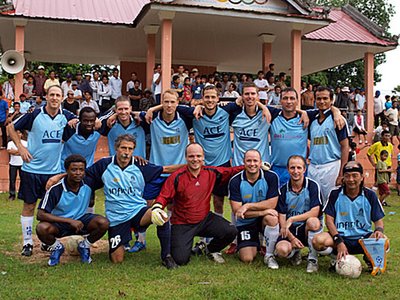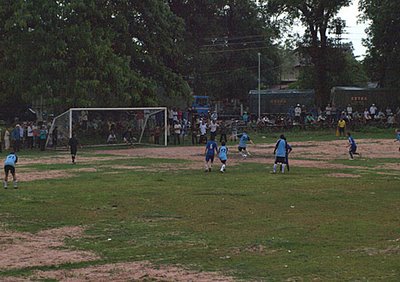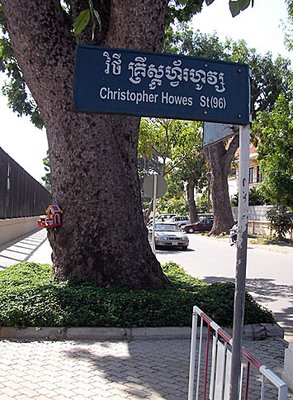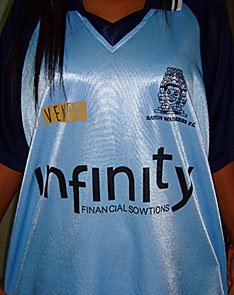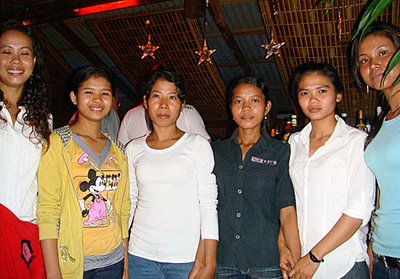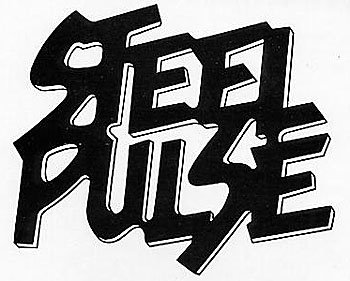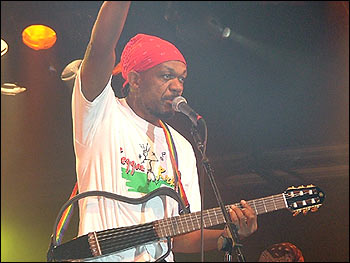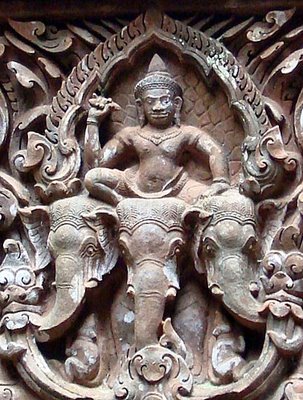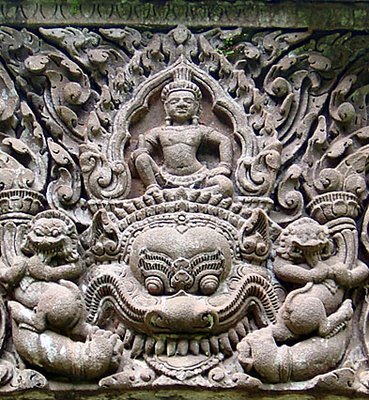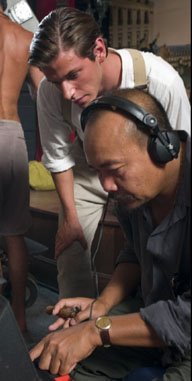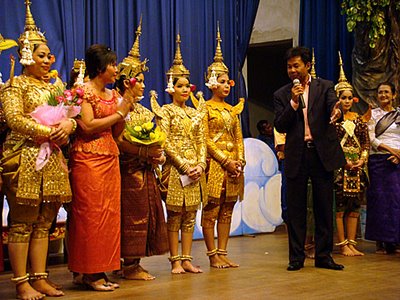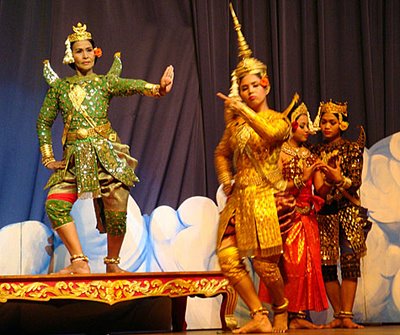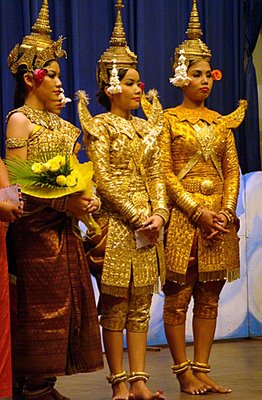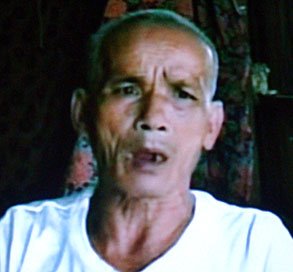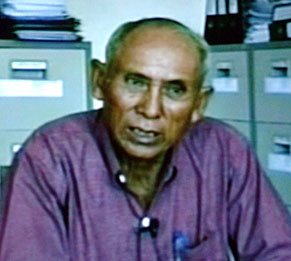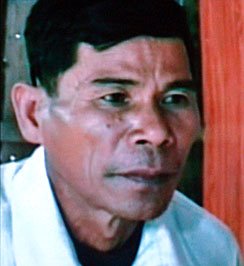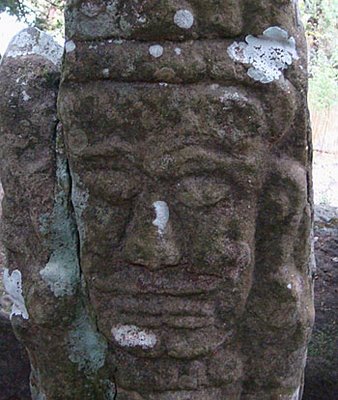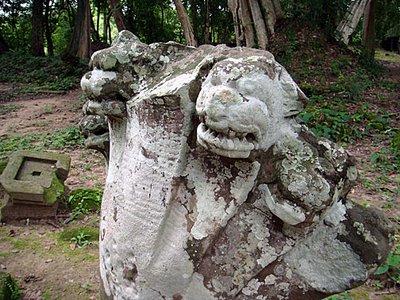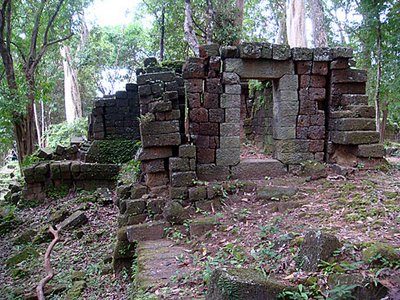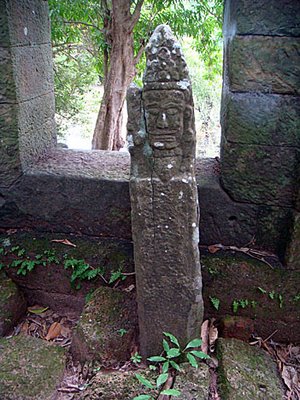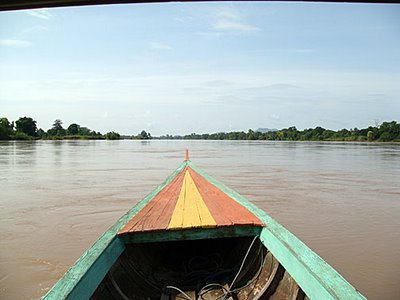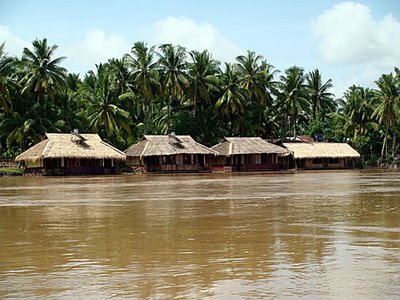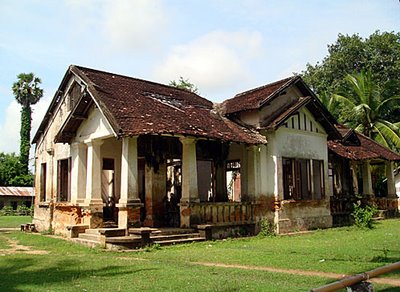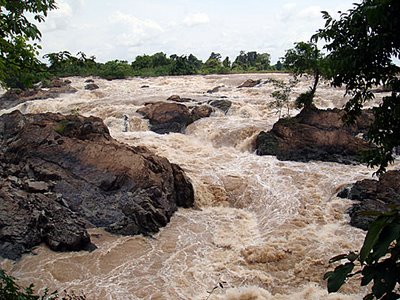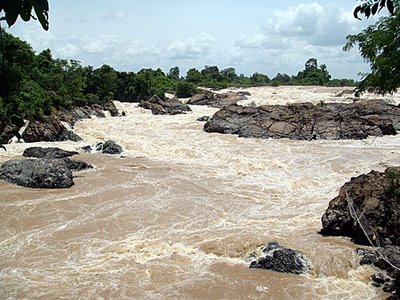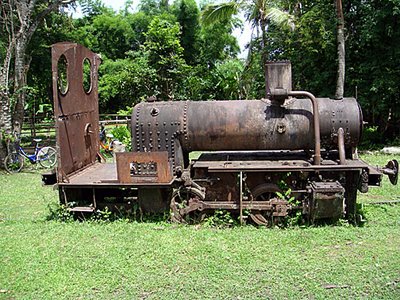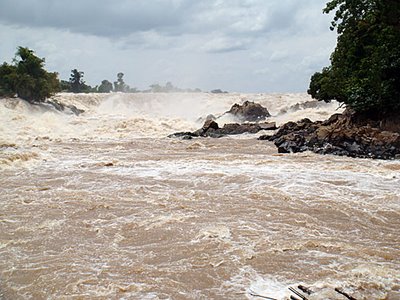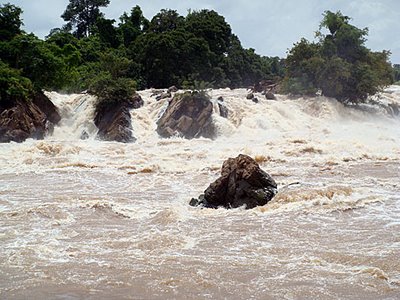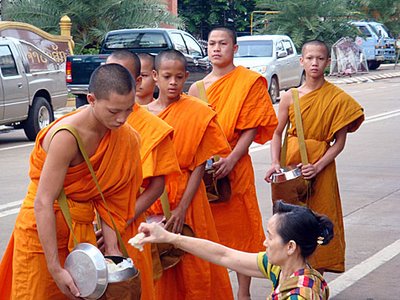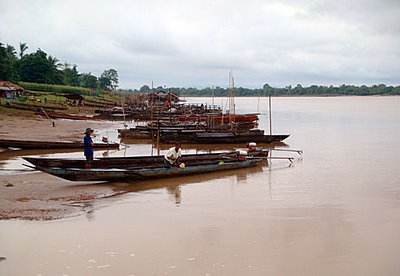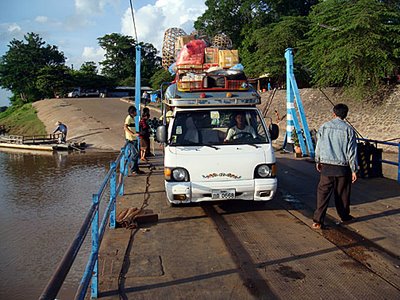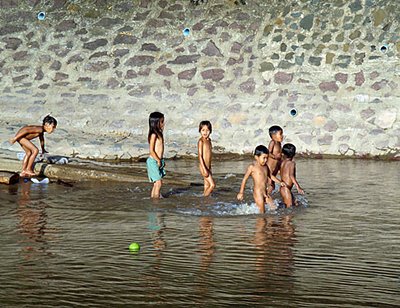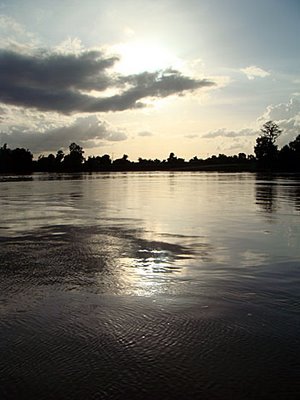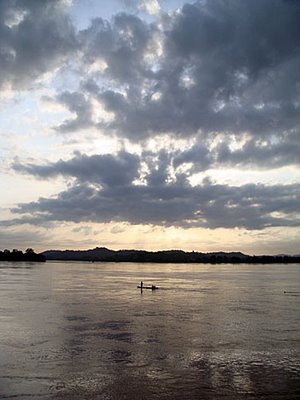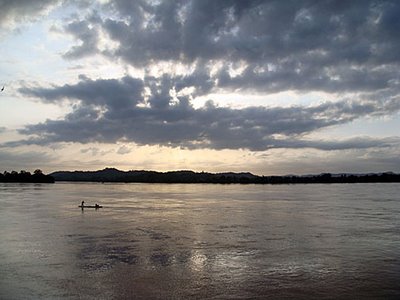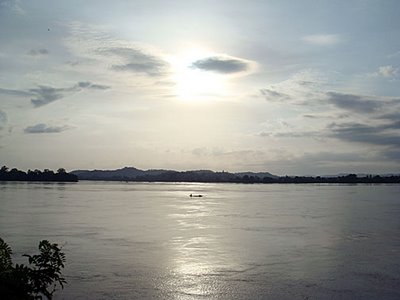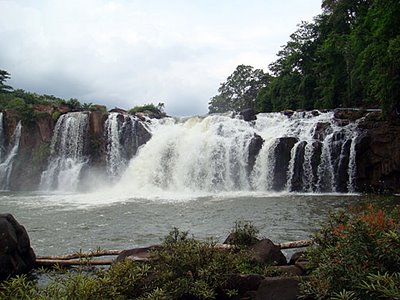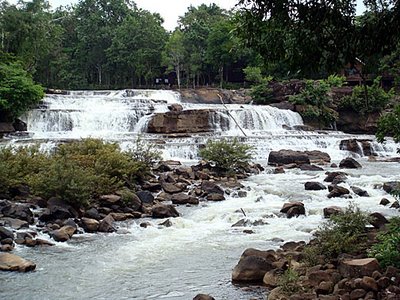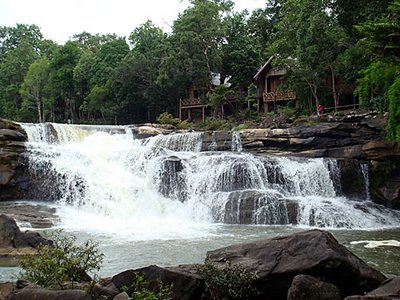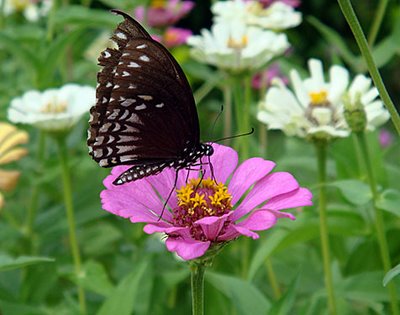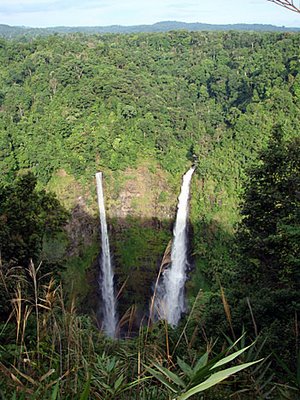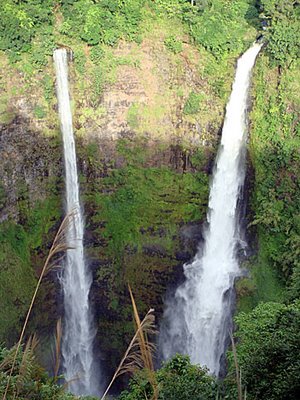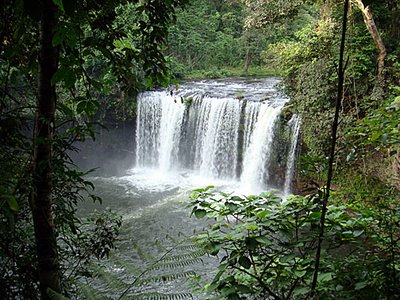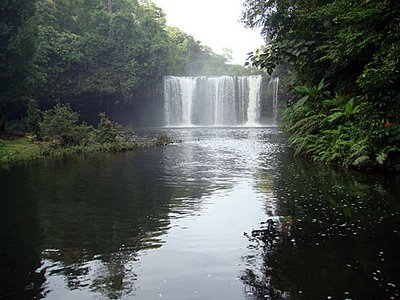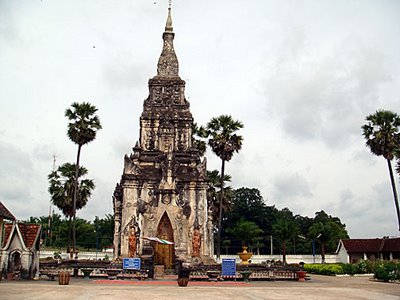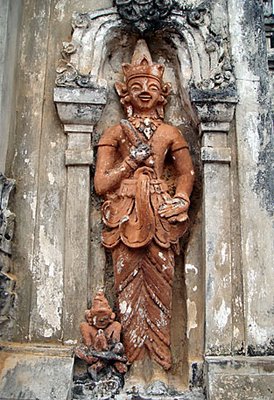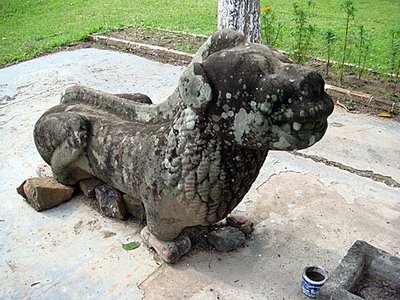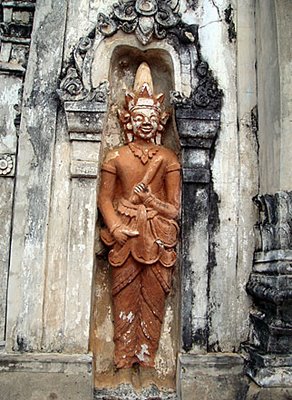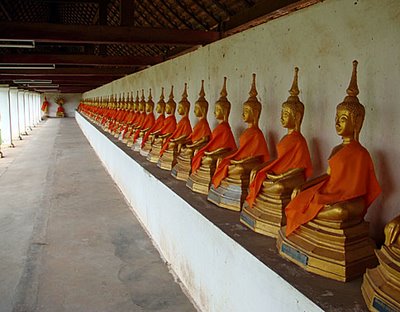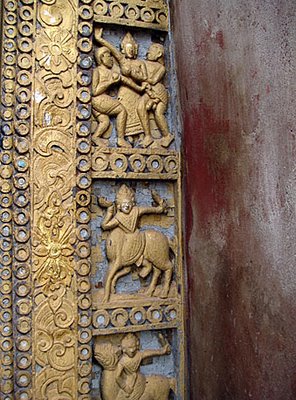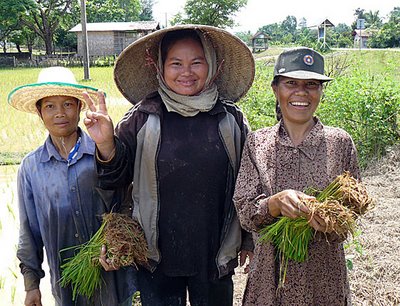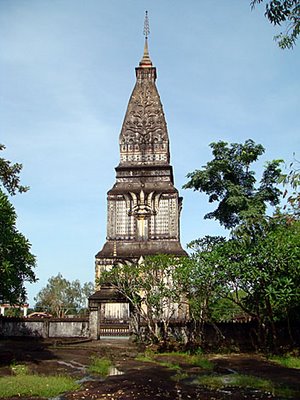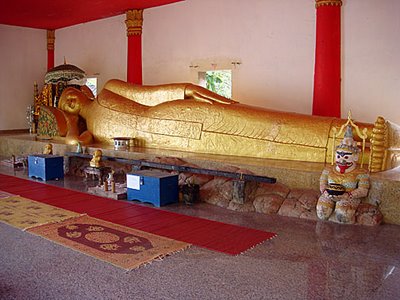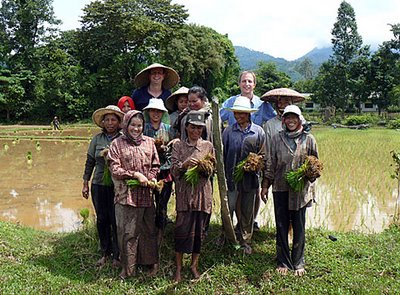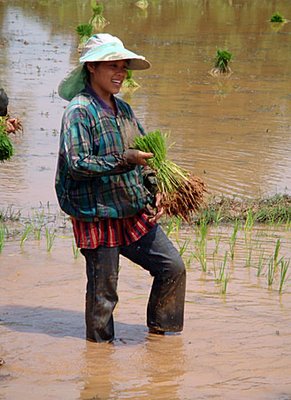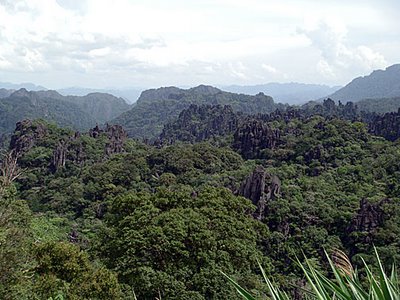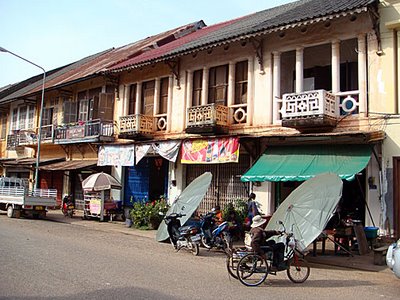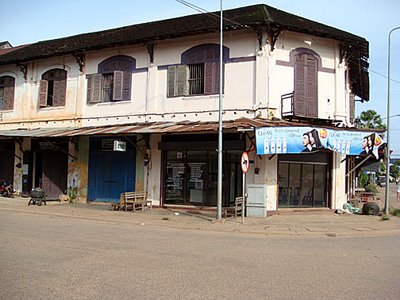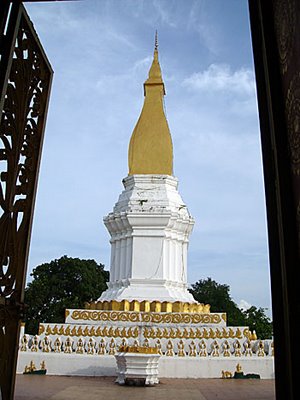Tuesday, September 30, 2008
Saturday, September 27, 2008
Traffic hell
Blog Holiday
Friday, September 26, 2008
Tarnished reputation
It's a busy old weekend ahead. The 15-day Buddhist ceremony of P'chum Ben will end on Tuesday as Khmers all over the country visit their preferred pagodas with food and offerings for the sprits of their dead ancestors. I was planning on a visit to Battambang but plans have changed and now I will head for Kompong Cham tomorrow for a couple of days and fit in my pagoda visit, starting at 4am, on Sunday. As I'll be in the sticks, this blog will have a brief holiday too.
In case you weren't aware, tomorrow is World Tourism Day 2008 and Peru will be the focus as tourism chiefs concentrate on how to promote sustainable tourism whilst incorporating environmental, socio-economic and climatic concerns. Good luck guys. The new Cambodian government were sworn in yesterday, with just about everyone and their dog getting a ministerial job, except me. Oh, and the return of Prince Norodom Ranariddh is scheduled for Sunday after he received a royal pardon from his brother the King, for the embezzlement conviction he acquired last year. I don't think anyone will get the flags out.
Thursday, September 25, 2008
Dead as a dodo
Football funnies
I have a few more chances to watch the national team next month, when they host the AFF Suzuki Cup 2008 Qualifying Tournament. Two teams will progress through to December's finals to be played in Thailand and Indonesia and Cambodia's matches will be against Laos (17th October), East Timor (19th), Philippines (23rd) and Brunei (25th). See you there.
Baby news
 300 actors are expected to take part in next month's Lakhaon International Theatre Festival in Phnom Penh. It'll be held at the Chenla Theatre between 3-9 October, it's free and will showcase traditional theatre styles from Cambodia, France and other Asian countries, though the Khmer styles (and there are many) will dominate with seven of the twelve plays being featured. The festival is being hosted by the French Cultural Centre, so annoyingly much of the publicity is in French though if you search the CCF website you will find a few scant words in English about the event. One day they will wake up and realize the world speaks English, not French.
300 actors are expected to take part in next month's Lakhaon International Theatre Festival in Phnom Penh. It'll be held at the Chenla Theatre between 3-9 October, it's free and will showcase traditional theatre styles from Cambodia, France and other Asian countries, though the Khmer styles (and there are many) will dominate with seven of the twelve plays being featured. The festival is being hosted by the French Cultural Centre, so annoyingly much of the publicity is in French though if you search the CCF website you will find a few scant words in English about the event. One day they will wake up and realize the world speaks English, not French.This coming Saturday, 27th, the Chenla Theatre will also host another free event, the Cracking Bamboo International Percussion Festival from 7pm. Performers of differing nationalities will join together for this mini extravaganza of percussion, old and new. Get along if you can.
Wednesday, September 24, 2008
Hot springs
I found the article while I was searching for stilted villages in and around the Tonle Sap Lake. I've been to a few villages on the shores of the lake (ie. Kompong Phluk, Kompong Khleang, Kompong Luong, Chong Khneas, etc) but there are many more that are waiting to be visited, if only I had, a) the time and b) the necessary transport. My 'fisheries' insider tells me there are plans to develop more eco-tourism sites around the Tonle Sap Lake and beyond but the locations are yet to be confirmed and more details may be available by the end of the year. They didn't say which year!
Tuesday, September 23, 2008
Prey Lang under threat
 A brother and sister filmmaking team, Ben and Jocelyn Pederick from Australia, carried off the main award from last week's Environmental and Conservation Film Festival with their eleven-minute short film Prey Lang: One Forest. One Future. It's effectively a trailer for an hour-long film they are completing to tell people about the Prey Lang forest that covers parts of Preah Vihear, Stung Treng, Kratie and Kompong Thom provinces and the challenges it's facing in the future. Prey Lang is the largest primary lowland dry evergreen forest remaining in both Cambodia and Indochinese Peninsula and it’s in jeopardy. With an estimated 700,000 people relying on the forest for survival, logging and mining interests have the potential to destroy this critical, fragile and ancient forest habitat. Healthy wildlife populations including endangered species such as elephants, gaur, banteng, tiger and Asiatic black bears are all at risk as well as the indigenous Kuy communities who protect and rely on the forest for their daily needs. You can find out more about Prey Lang and the documentary here.
A brother and sister filmmaking team, Ben and Jocelyn Pederick from Australia, carried off the main award from last week's Environmental and Conservation Film Festival with their eleven-minute short film Prey Lang: One Forest. One Future. It's effectively a trailer for an hour-long film they are completing to tell people about the Prey Lang forest that covers parts of Preah Vihear, Stung Treng, Kratie and Kompong Thom provinces and the challenges it's facing in the future. Prey Lang is the largest primary lowland dry evergreen forest remaining in both Cambodia and Indochinese Peninsula and it’s in jeopardy. With an estimated 700,000 people relying on the forest for survival, logging and mining interests have the potential to destroy this critical, fragile and ancient forest habitat. Healthy wildlife populations including endangered species such as elephants, gaur, banteng, tiger and Asiatic black bears are all at risk as well as the indigenous Kuy communities who protect and rely on the forest for their daily needs. You can find out more about Prey Lang and the documentary here.The World Savers Awards recognize companies that are innovative in five key areas: poverty alleviation, cultural and/or environmental preservation, education, wildlife conservation, and health. Yesterday at the Conde Nast Traveler's World Savers Congress in New York, six companies were named winners and they included Cambodia-based Journeys Within, for Health Initiatives. The tour operator's non-profit arm has added more than 180 water wells to the landscape around Siem Reap, helping nearly 4,000 Cambodians to avoid water-related disease. They also offer scholarships for university students, hold free English classes, and provide micro-loans for small businesses in Cambodia. Well done JW.
Grand old dame
Sunday, September 21, 2008
Comeback kings
Saturday, September 20, 2008
Food for thought
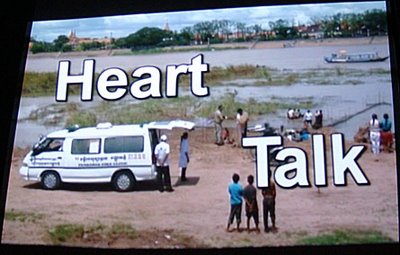 This is the opening scene from the brand new movie, Heart Talk by Khmer Mekong Films showing a woman's body being hauled out of the Tonle Sap River opposite the Royal Palace in Phnom Penh. It's KMF's second feature-length film and they took the opportunity to test the water with a preview audience screening at Meta House tonight. The moviegoers were asked to complete questionnaires at key points of the screening and their input will give KMF some food for thought before the production is finalized, ready for its introduction to Khmer cinema fans. As for the film itself, it was set in Cambodia's capital at a fictitious radio station, where two women presenters disappear and the male employees are in the frame before a final twist in what was a well-paced thriller-whodunit, led by Saray Sakana as Maly, the heroine and Pov Kisan as Heng the detective, better known as a comedy actor. Having the film set in various locations around the capital added to the interest for me and with some finishing touches here and there will see a film that local audiences should enjoy.
This is the opening scene from the brand new movie, Heart Talk by Khmer Mekong Films showing a woman's body being hauled out of the Tonle Sap River opposite the Royal Palace in Phnom Penh. It's KMF's second feature-length film and they took the opportunity to test the water with a preview audience screening at Meta House tonight. The moviegoers were asked to complete questionnaires at key points of the screening and their input will give KMF some food for thought before the production is finalized, ready for its introduction to Khmer cinema fans. As for the film itself, it was set in Cambodia's capital at a fictitious radio station, where two women presenters disappear and the male employees are in the frame before a final twist in what was a well-paced thriller-whodunit, led by Saray Sakana as Maly, the heroine and Pov Kisan as Heng the detective, better known as a comedy actor. Having the film set in various locations around the capital added to the interest for me and with some finishing touches here and there will see a film that local audiences should enjoy.Postscript: A mug-shot of me at the screening appeared in Monday's Phnom Penh Post in a page of Around Town mug-shots. I didn't look happy about it!
An aid to being responsible
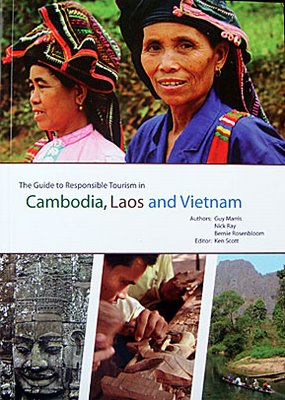 Responsible Tourism is one of the latest buzzwords that we hear, especially in a country like Cambodia, where it's almost a dirty expression to be just a tourist, you need to be responsible, pro-poor, green or an advocate of eco-tourism and so on. To help us understand more about this latest fad and to identify some tourism activities or projects that visitors can get involved in whilst in and about the Mekong region, a new booklet, the 148-page Guide to Responsible Tourism in Cambodia, Laos and Vietnam, has been published. In it, 88 so-called responsible tourism activities are described from the three countries of the lower Mekong area, with 28 from Cambodia ranging from the PEPY Ride, to the Starfish Bakery in Sihanoukville to the circus in Battambang, Phare Ponleu Selpak. You'd think such a booklet would be free, following the example set by the Stay Another Day publication that promotes sustainable tourism and overlaps in many areas, but the latest guide is only available from the Ministry of Tourism for the pricely sum of $15. That's just plain crazy - I can't see many takers at that price. The Cambodia section has been written by Nick Ray of LP fame.
Responsible Tourism is one of the latest buzzwords that we hear, especially in a country like Cambodia, where it's almost a dirty expression to be just a tourist, you need to be responsible, pro-poor, green or an advocate of eco-tourism and so on. To help us understand more about this latest fad and to identify some tourism activities or projects that visitors can get involved in whilst in and about the Mekong region, a new booklet, the 148-page Guide to Responsible Tourism in Cambodia, Laos and Vietnam, has been published. In it, 88 so-called responsible tourism activities are described from the three countries of the lower Mekong area, with 28 from Cambodia ranging from the PEPY Ride, to the Starfish Bakery in Sihanoukville to the circus in Battambang, Phare Ponleu Selpak. You'd think such a booklet would be free, following the example set by the Stay Another Day publication that promotes sustainable tourism and overlaps in many areas, but the latest guide is only available from the Ministry of Tourism for the pricely sum of $15. That's just plain crazy - I can't see many takers at that price. The Cambodia section has been written by Nick Ray of LP fame.I am just back from the very geeky BarCamp Phnom Penh, held at the Foreign Languages University campus and very well-attended by a nice cross-section of expats and Khmers, eager to soak up the IT vibes radiating from every corner. It was an all-day informal affair so I turned up for the free lunch and the early afternoon sessions, one of which, 'how to date a Khmer girl', was of particular interest. Other more earnest presentations were on offer, most of which went way over my head, but were lapped up by the IT-savvy computer nerds in attendance. Nice to meet a few fellow bloggers at the type of event that will undoubtedly enthuse and excite those thirsty for new technology.
Friday, September 19, 2008
Jacobsen rewrites history
Better late than never
Heart to heart
 A free preview screening of the new feature-length movie Heart Talk tomorrow night at Meta House will give the audience the chance to offer their views with an after-screening focus group session. The film, a second feature made by Khmer Mekong Films (KMF), directed by Tom Som and written by Brit Matt Baylis, is a contemporary thriller in which three female radio station presenters face mortal danger, with talented actress Saray Sakana (pictured) playing the lead role of Maly. The action starts at 7.15pm tomorrow night at Phnom Penh's Meta House on Street 264.
A free preview screening of the new feature-length movie Heart Talk tomorrow night at Meta House will give the audience the chance to offer their views with an after-screening focus group session. The film, a second feature made by Khmer Mekong Films (KMF), directed by Tom Som and written by Brit Matt Baylis, is a contemporary thriller in which three female radio station presenters face mortal danger, with talented actress Saray Sakana (pictured) playing the lead role of Maly. The action starts at 7.15pm tomorrow night at Phnom Penh's Meta House on Street 264.KMF are also celebrating winning a US Freddie film award, the medical world's equivalent of the Oscars, for their powerful half-hour drama about the importance of HIV tests for pregnant women, called Facing The Truth. Find out more about KMF and their heavy filming schedule here.
Thursday, September 18, 2008
Lost Goddesses of Cambodia
 To hear more about the plight of women in Cambodia, anthropologist Trudy Jacobsen (pictured) will present her new book, Lost Goddesses: The Denial of Female Power in Cambodian History at a talk and book-signing event at Monument Books on Norodom Boulevard in Phnom Penh from 6.30pm tomorrow (Friday 19th).
To hear more about the plight of women in Cambodia, anthropologist Trudy Jacobsen (pictured) will present her new book, Lost Goddesses: The Denial of Female Power in Cambodian History at a talk and book-signing event at Monument Books on Norodom Boulevard in Phnom Penh from 6.30pm tomorrow (Friday 19th).Jacobsen has lived and worked in Cambodia for quite a few years, took courses in anthropology, archaeology, women's studies, Sanskrit, and Asian history before gaining her PhD in 2004. Since then she's held fellowships abroad before returning to Cambodia to lecture on contemporary gender issues in Southeast Asia at the
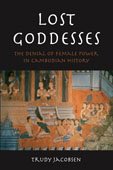 Centre for Khmer Studies and Norton University, and as a project advisor at the Buddhist Institute in Phnom Penh. Her book was published last year by the Nordic Institute of Asian Studies, who were responsible for two books last Spring that gave a greater focus on women in Cambodia and the uphill battle they face. Lost Goddesses highlights the lofty position women once held against their struggle to regain that lost ground today, whilst Mona Lilja's book, Power, Resistance and Women Politicians in Cambodia: Discourses of Emancipation gave a unique insight into the political struggles of Cambodian women.
Centre for Khmer Studies and Norton University, and as a project advisor at the Buddhist Institute in Phnom Penh. Her book was published last year by the Nordic Institute of Asian Studies, who were responsible for two books last Spring that gave a greater focus on women in Cambodia and the uphill battle they face. Lost Goddesses highlights the lofty position women once held against their struggle to regain that lost ground today, whilst Mona Lilja's book, Power, Resistance and Women Politicians in Cambodia: Discourses of Emancipation gave a unique insight into the political struggles of Cambodian women.
Nick Ray in today's Post
Arriving as a location scout for Tomb Raider - the movie that put Angkor back on the tourist map - Lonely Planet's Nick Ray knows his Siem Reap - by Peter Olszewski, Phnom Penh Post
 The Siem Reap-Angkor complex has notched up another world first this month, becoming the first of three regional centres, and the first non-coastal attraction, to be featured in Lonely Planet's new Encounter books, aimed at short-term travellers. The series was launched in May last year, initially as city guides to locations such as London, Paris and Barcelona. The publishers decided to expand this concept to regional centres and this month released three books: one each on Phuket, Ko Samui and Siem Reap-Angkor. "Despite the headlining act that is Angkor, Lonely Planet says Siem Reap has its newfound status as Asia's historic hotspot," the publisher stated. "And in recent times, the town has undergone a metamorphosis from a quaint village to a centre for the international jet set."
The Siem Reap-Angkor complex has notched up another world first this month, becoming the first of three regional centres, and the first non-coastal attraction, to be featured in Lonely Planet's new Encounter books, aimed at short-term travellers. The series was launched in May last year, initially as city guides to locations such as London, Paris and Barcelona. The publishers decided to expand this concept to regional centres and this month released three books: one each on Phuket, Ko Samui and Siem Reap-Angkor. "Despite the headlining act that is Angkor, Lonely Planet says Siem Reap has its newfound status as Asia's historic hotspot," the publisher stated. "And in recent times, the town has undergone a metamorphosis from a quaint village to a centre for the international jet set."The book is compiled by Nick Ray, a familiar name to Lonely Planet aficionados as he's authored a host of guide books. With this publication, he emerges as the world's foremost expert on Siem Reap, despite not being a resident. Ray lives in Phnom Penh, and some mutterings have emerged that it's a bloody disgrace that the world's foremost expert on Siem Reap is a blow-in from the big smoke down south. But, as Ray asserts, he packs plenty of Siem Reap cred. While he has never called Siem Reap home, he's been a regular visitor for many years. "I've spent a lot of time in Siem Reap on projects," he declared. "When I worked on Tomb Raider I lived here for about four months, and I tend to go there at least ten times a year. Ray was a location and logistics guide for the Tomb Raider movie and, if one accepts the notion that the movie helped put Angkor on the international tourist map, he deserves honorary Siem Reap residency for his role in the location being chosen for the movie.
To recap Hollywood-meets-Siem Reap history, Tomb Raider, the first Hollywood movie filmed in Cambodia since Peter O'Toole's 1964 Lord Jim, was originally slated to be a Chinese-located movie based around the Terracotta Army coming to life. But that concept was pulled when a Chinese movie featured the army. Cambodia was next on the list because in early 2000, Cambodian expat personality and prominent blogger, Andy Brouwer, was in Gloucester, England. He was visited by Sam Breckman, the London-based locations manager for Paramount, who had seen his website, and wanted to discuss the possibility of using Cambodia as a location for an Oliver Stone movie, Beyond Borders. Nick Ray, who had already edited a Cambodian guide book, was also in the UK. Brouwer introduced Breckman to Ray, and within a week Ray and the producer flew to Cambodia. Cambodia was chosen as the venue for that movie, but Stone pulled out. Paramount temporarily shelved that project, but opted to use Angkor for Tomb Raider. Ray told the Post he was aware at the time of filming that the movie would have a big impact on Angkor. "That was very much foremost in our minds, because it was obvious that Angkor was coming into prominence and Cambodia was no longer solely being associated with genocide and the Khmer Rouge and terrible things," he said. "Tomb Raider was a turning point in Cambodia's history. And now I watch tour guides completely inventing stories about what happened during the filming of the movie."
Ray's Siem Reap Encounter book reflects his extensive knowledge and fondness of the area. "I absolutely enjoy the place," he said. "One of the things I like most about Siem Reap today is the variety of restaurants and that it's now a lively town, which it never used to be. You can dine on very good Cambodian food, Asian food, international food, and then stay out quite late - unlike in Hanoi or Bangkok where they have curfews. It's a very open place now, and quite international. This has happened over the last five years, and the real take-off was from about 2003 and 2004. Before that there were only a few bars in Siem Reap. The first one was Angkor What?, which opened in early 1999 even though they claim they opened in early 1998, then the Red Piano, and Ivy." Ray said he also loves the back streets and side alleys of Siem Reap, which many tourists never get to see. "Another of my favourites is the shady back lanes. Following the east bank of the river further north from the Royal Residence residency, you have a lot of wats. It's a pretty area, with local street markets, more like the 'real' Cambodia.
Ray of course cites the temples and Tonle Sap as other wonders, but he does have criticisms about Siem Reap's unplanned sprawl. "The traffic is getting bad, and returning from the temples in tourist rush hour in the late afternoon is fairly crazy. There's also a lack of focus in the planning. There's not enough vision of where Siem Reap needs to go, or any attempt to control this development in a positive way. Everyone in Siem Reap seems to be playing catch up. It would be nice for them to get ahead of themselves, and have plans in place rather than constantly trying to rectify earlier problems."
Article copyright Phnom Penh Post & Peter Olszewski
Empowering others
Woman establishes school in Cambodia - by Stina Sieg, Glenwood Springs Post Independent
In an act of charity, it takes real love to empower people, rather than make them depend on you. Kari Grady Grossman has come to understand that. The reason why is quite a journey. In 2001, she was a freelance journalist, working for the Discovery Channel’s website and living in the mountains of Wyoming. These days, she’s a Front Range mother of two adopted children, an award-winning author and founder of a successful school in her son’s native home of Cambodia. "To be honest with you, I’m kind of in awe,” she said. She’s not the only one. Her recent book, “Bones That Float: A Story of Adopting Cambodia” has won several accolades, and Grossman herself has been named “Peacemaker of the Year” by the Independent Publisher Book Awards. She’s given presentations across the country, and thousands have bought her memoir. People seem eager to hear her story. That doesn’t mean, however, that it’s a simple one to tell.
Her connection to Cambodia began when she and her husband, George, wanted to start a family and faced infertility. World travelers already, they thought of international adoption immediately. Grossman liked the idea of being part of some distant place. “You’re not just American anymore,” she explained. “You’re Cambodian-American. You’re Indian-American. You’re really connected with your child’s history.” She completely took that to heart. After adopting Grady, now 8, from an orphanage, she learned about his country’s complex history, about the abhorrent acts committed by its government and the role our own government had there. What she saw was a corrupt, war-torn nation, and she just wanted to help. Full of empathy and good intent, she started up the Grady Grossman School in a small, mountain town and began a nonprofit to support it. For years, she acted mostly in a fundraising capacity. Her efforts were valiant, but something was missing. She wanted more for these people. “It wasn’t very empowering for them to depend on a nice girl in Colorado to raise money for them,” she explained, “And (what) we really needed to do with that community was empower them to support their own school.”
What she was dealing with was a culture so used to foreign aid that its citizens felt entitled to it. It was frustrating for Grossman, as she wanted these people to feel they could help themselves. At Grossman’s school there were constant absences of both teachers and students, and some of the surrounding areas were completely deforested, as the trees were cut for fuel. The two issues might seem divergent, but they weren’t. It all stemmed from an economic and social depression, one that discouraged any form of creative problem solving. These people didn’t feel ownership over their own lives, and they’d been scared into silence about it for years by their government. They were desperate and had no idea how to make things better.
So Grossman decided to shake everything up for them. These days, the Grady Grossman School is completely different than before. Teachers want to be there, because they’re compensated extra for their attendance. The town’s environmental nightmare has been squelched, as Grossman found the residents a way to make briquettes out of waste instead of using wood. The manufacturing of this burnable material generates income, as well, which helps the residents stay afloat, and allows more kids to stay in class. Instead of just being given funds, people have to work for them. If they want a library or some other addition, they have figure out how to pay for it. Slowly, the people who want change are taking over the reigns of their lives — economically, socially and educationally. Strangely, by making the villagers more fiscally accountable, it’s as though Grossman’s setting them free. “Our mission is to empower communities to sustain schools through economic development,” she said, adding later, “We’ve kind of stumbled on a real answer.”
In America, her nonprofit, formally known as Friends of the Grady Grossman School, is now Sustainable School International. As she sees it, this is a totally new way of running a charitable organization. She can’t help but want to spread it far and wide. But, of course, when it comes to dealing with people, nothing is cut and dried. Though her family moved to Fort Collins to be closer to a major airport recently, Grossman can’t always be in her adopted village to oversee things. She has Grady and her 4-year-old daughter, Shanti (from India) to take care of. In her absence, all kinds of things can happen. People can make mistakes and argue and use poor judgment. They’re human. They are what makes Grossman’s efforts so complicated and trying — and absolutely rewarding, too. This is really about people, after all, not the schools. “You’re telling them you believe in them,” she said. And that’s what makes all this possible.
Wednesday, September 17, 2008
Prehistory under threat
Howes trial update
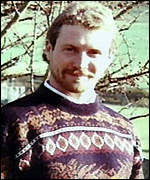 I've been waiting patiently for developments in the trial of the alleged killers of British deminer Christopher Howes (left) and his Cambodian interpreter Houn Hourth, who were murdered in cold blood a few days after their abduction by the Khmer Rouge in March 1996. Today's Phnom Penh Post carries the story that the Municipal Court in Phnom Penh may open the trial of five former Khmer Rouge guerrillas sometime this month, but more likely the beginning of October. In a surprise move last November, three ex-rebels were arrested and charged with the kidnapping and murder of the two deminers, the alleged mastermind Khem Nguon, Loch Mao and Chep Cheat. Nguon, who served as number 2 to the notorious one-legged KR commander Ta Mok, had defected from the rebels to join the Cambodian armed forces at the end of 1998, and was awarded the rank of brigadier-general in the defence ministry. The others became civil servants. Loch Mao has been identified as the man who is believed to have shot Howes in the back. Two other arrests were made in May this year, of Sin Dorn and Puth Lim. All five men face 20 years in prison for premeditated murder and 10 years for illegal confinement if convicted. They have been held at Prey Sar prison since their arrests. The names of the killers had been known to the Cambodian authorities for many years but the appetite for taking former Khmer Rouge cadre into custody only gathered steam with the progress of the Tribunal and the arrest of senior KR leaders. Twelve years after the murders of Christopher Howes and Houn Hourth, we may just see justice prevail at long last. For a detailed look at the history of this case, click here.
I've been waiting patiently for developments in the trial of the alleged killers of British deminer Christopher Howes (left) and his Cambodian interpreter Houn Hourth, who were murdered in cold blood a few days after their abduction by the Khmer Rouge in March 1996. Today's Phnom Penh Post carries the story that the Municipal Court in Phnom Penh may open the trial of five former Khmer Rouge guerrillas sometime this month, but more likely the beginning of October. In a surprise move last November, three ex-rebels were arrested and charged with the kidnapping and murder of the two deminers, the alleged mastermind Khem Nguon, Loch Mao and Chep Cheat. Nguon, who served as number 2 to the notorious one-legged KR commander Ta Mok, had defected from the rebels to join the Cambodian armed forces at the end of 1998, and was awarded the rank of brigadier-general in the defence ministry. The others became civil servants. Loch Mao has been identified as the man who is believed to have shot Howes in the back. Two other arrests were made in May this year, of Sin Dorn and Puth Lim. All five men face 20 years in prison for premeditated murder and 10 years for illegal confinement if convicted. They have been held at Prey Sar prison since their arrests. The names of the killers had been known to the Cambodian authorities for many years but the appetite for taking former Khmer Rouge cadre into custody only gathered steam with the progress of the Tribunal and the arrest of senior KR leaders. Twelve years after the murders of Christopher Howes and Houn Hourth, we may just see justice prevail at long last. For a detailed look at the history of this case, click here.Tuesday, September 16, 2008
Eye, eye
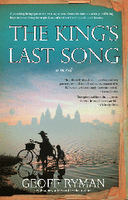 Even though I can't see it for myself... the best novel on Cambodia for a long, long time, Geoff Ryman's The King's Last Song, has just been unleashed onto an American audience for the first time by Small Beer Press. Originally published by HarperCollins two years ago, the new edition has an extended afterword by the author in which Ryman notes how both his sources and experiences added to the writing of the novel. In it, Ryman brings some substance, albeit fictional, to the life and times of the god-King Jayavarman VII, and he does it brilliantly in my view. If you haven't read the novel yet, I implore you to get out there and buy it. Find out more here.
Even though I can't see it for myself... the best novel on Cambodia for a long, long time, Geoff Ryman's The King's Last Song, has just been unleashed onto an American audience for the first time by Small Beer Press. Originally published by HarperCollins two years ago, the new edition has an extended afterword by the author in which Ryman notes how both his sources and experiences added to the writing of the novel. In it, Ryman brings some substance, albeit fictional, to the life and times of the god-King Jayavarman VII, and he does it brilliantly in my view. If you haven't read the novel yet, I implore you to get out there and buy it. Find out more here.The publisher's blog reports: The cover of Geoff Ryman’s The King's Last Song is made up of two photos, one by Pablo Carral Vega (from Corbis) and one by Jeremy Horner (Panos). Our cover is a variation on the UK HarperCollins edition with a new typeface, new text, and so on. The files we got from HarperCollins were complicated, quite beautiful, and fascinating to work with. This book sold pretty well in the UK so we are sending it out far and wide to try and generate some good reviews and word of mouth. There aren’t many novels set in Cambodia (either modern day or historical) so this one fills a gap. Booklist gave it a starred review and Library Journal gave it a strong recommendation. We, of course, do too! It’s a gobsmackingly-large canvas novel to dive into - very much autumn out on the hammock reading. Geoff is teaching this semester at UC San Diego (where he just taught at the Clarion Workshop, too), so if you’re in the area look out for possible readings.
Monday, September 15, 2008
Can you believe it?
This coming Saturday (20th), all computer geeks, nerds, techies and enthusiasts will be heading for the Cambodia-Japan Cooperation Center on Russian Boulevard at 9am til 5pm to share information about technology, blogging and the like. Over 100 people will be at Bar Camp Phnom Penh on Saturday and if it tickles your fancy, log in here for more infomation.
Sunday, September 14, 2008
Chhnang chumps
Clarkson on Cambodia
Jeremy Clarkson's career as car reviewer and BBC Top Gear presenter has made motoring into show business, but he has earned himself the description of an "equal opportunities loudmouth" for his opinionated commentary on all aspects of life, appearing weekly in The Sunday Times. Clarkson was also in Cambodia recently, on a family holiday. Here's what he's written in his UK Times OnLine column today.
Miss Street-Porter, I have a job for you in Cambodia
Since we’re told charity begins at home, it’s better, I’ve always thought, to give £1m to a hapless British person than 10p to an organisation that provides sandwiches for prisoners in Turkey. Now, however, I have decided that, actually, charity begins in Cambodia. Some people get all dewy-eyed about Africa. That’s jolly noble, but I don’t see the point because I fear that no matter how much money you pump in, the bejewelled pigs that run the place will pump it straight back out again, into the coffers of Kalashnikov and Mercedes-Benz. The only thing I’d send to the dark continent is a team of SAS hitmen to shoot the likes of Mr Mugabe in the middle of his face. Others would say that we have enough problems on our own shores without getting all teary over the children of Mr Pot. I disagree, because these days, every time I think of underprivileged people in Britain, the hideous face of Shannon Matthews’s mum pops into my head, all greasy, fat and stupid, and it’s hard to summon up any sympathy at all.
Cambodia, though, is different. It’s a country of 14m people but between them they have only about 5m legs. In fact, there are 25,000 amputees, the highest ratio per capita of any country in the world. This is not because Cambodians are especially clumsy. It is because of landmines. Nobody knows how many mines were laid during the endless cycle of warfare, but it’s sure to be in the millions. What we do know is that since the Vietnamese invaded in 1979 and drove the madman Pol Pot into the hills, 63,000 people have trodden on one. One man has had his left leg blown off four times. They gave him a good prosthetic after the first and second explosions, but since then he’s had to make his own out of wood.
And it’s still going on today. In most places in the world, you can get three rice harvests per year from your paddy field. In Cambodia, it’s one. This is partly because the Khmer like a weird sort of rice that’s harder to grow, but mostly it’s because you set off with your plough and within minutes there’s a big bang and your water buffalo has become a crimson mist. As a result of the ordnance lying in every field, no one is fighting for a right to roam in Cambodia. They have no equivalent of the Ramblers Association. They have no concept of Janet Street-Porter. In fact they have no concept of England. Because the education is so poor, most people there believe the world is made up of four countries: Thailand, Laos, Cambodia and Vietnam. Everywhere else is France. All white people are therefore French. Angelina Jolie, who adopted a Cambodian baby, does much to help clear the landmines and has been made a Cambodian citizen, is French. I was French. And every night, most of the men settle down to watch Manchester United and Chelsea slug it out for honours in the French Premier League. I’d never met an adult anywhere in the world (apart from America) who’d never heard of Great Britain. In Cambodia nobody had.
What’s more, you will never see a Cambodian person wearing sunglasses. Mainly this is because the average wage in Cambodia is less than £400 a year and so Ray-Bans are a bit out of range. But also it’s because Cambodians all have flat noses. So sunglasses simply fall onto the floor every time you hop to the shops, and every time your buffalo explodes. That’s what did it for me. The sunglasses. Not the education. Not the notion of living in a country where there is no Janet Street-Porter. The landmines made my eyes prickle, but my heart just mushroomed over the idea that they can’t afford to wear shades. And that even if they could, they’d keep falling off.
I have therefore decided that I must do something. Unfortunately, however, we all reach a point like this when we decide we must help, and then it’s so very hard to know what should be done next. Secretly we all know that for every pound we donate to a large charity, only 2p actually reaches the people we have in mind. The rest is spent on adverts for highly paid co-ordinators in The Guardian and expensive offices in London’s glittering West End. You always feel you want to go to the root of the problem. But in the bee that’s come to nest in my roost, that’ll be hard. Earlier this summer a team of Australian doctors happened upon a little girl in the town of Siem Reap. Her face had been horribly disfigured, by a bloody landmine I suppose, and they were overwhelmed with a need to help. They went to meet her parents, and her father was keen that his daughter be sent to Australia for plastic surgery. Her mother, however, went ballistic when she discovered the poor child would once again look normal. “How will she be able to beg then?” she asked. And the Aussie medics were sent packing.
I can’t even ring the Cambodian government for help because I fear it would be extremely enthusiastic and then all the money I sent over would be spent on fixtures and fittings in the finance minister’s next luxury hotel. That’s if I could raise any money in the first place. It’s hard when money’s tight here and everyone else has their own pet project. I suppose I could write to Ray-Ban asking it to design a cheap pair of shades that can be worn by someone who has no nose. But I think it’d be better if I started work on some designs for the most brilliant mine-clearing vehicle the world has ever seen. I’m thinking of strapping some ramblers together, and then . . .
Saturday, September 13, 2008
Getting the message across
30th anniversary for Handsworth Revolution
I have an unfinished 30,000 word biography of the band on my pc and here's a section of it that highlights the release and impact of that first album. Island Records had signed the band at the back-end of 1977 and their first single Ku Klux Klan reached the UK Top 50 despite limited airplay due to its controversial subject matter. The band were pleased with the single, so were the record company and work began on their first album. The band's Manager Pete King recalls the unanimous decision over the producer of the album. "Karl Pitterson was who we wanted. The main reason was that the band and I had heard the version (dub) side of a track he produced for Ras Ibuna called Diverse Doctrine.. the atmosphere, the echo, blew everyone away. Karl was already linked to Island...so everyone was happy with the choice." Pitterson was one of Island's heavyweight reggae producers and had previously worked with top Jamaican acts like Bob Marley on the album Exodus, Bunny Wailer and Peter Tosh. It proved a master-stroke. The chemistry between Pitterson and the band was electric, as guitarist Basil Gabbidon enthuses, "He was fantastic. Karl was like another member of the band and just a few years older. He brought clarity, precision, more arrangement, a tighter, professional feel and enhanced our sound by drawing it out of us. He improved the lead and backing vocals in particular." Drummer Grizzly Nisbett was also sincere in his appreciation of the band's early mentor. "Karl Pitterson took what we had, moulded it and made it better. We liked his production before we met him as we'd heard his stuff. He came to Linwood Road, sat on a speaker and listened. He liked what he heard. Karl was a musician, a producer, a writer and an engineer. One of the best. He brought out the musicianship in Steel Pulse. He showed us what we could do and what we were capable of. He pushed us in the right direction, how to do it and when to do it. We learnt a lot from him as far as studio work and techniques were concerned. We basically had no idea. We'd never really been in the studio before. We were fresh, nervous, it wasn't perfect but no other album sounded anything like Handsworth Revolution, thanks to Karl Pitterson." King remembers, "Not a great deal of preparation before recording began. We more or less put the live set on the album. The band would spend ages laying down the tracks, then go back to the hotel to rest. I would then spend hours with Karl mixing the tracks, with Godwin Logie also involved. I had an input though it would be hard to measure. I had a brilliant relationship with Karl, who brought with him a great vibe, good techniques and was one of the guys. Godwin was the tape op and was a lovely guy, an extra ingredient."
The result was their seminal debut album, Handsworth Revolution, released on 21 July 1978 to positive critical acclaim, even though Island supremo Chris Blackwell was allegedly a little uncomfortable with the inflammatory title. The cost of the album, with studio time at a premium, came out at around £40,000. The original illustration and concept for the album cover of a crumbling city with vegetation devouring the ruins was put together by the band's two former art students, David Hinds and Basil, though the final sleeve artwork was completed by graphic design student Andrew Aloof, working for the Bloomfield-Travis agency. I tracked Andrew down and he's now the Director of Art & Design at Hastings College in southern England and runs his own design company. "Bloomfield-Travis were the design company that got me involved. I'd just finished my graphic design degree and was doing well for myself as a freelance illustrator, in fact I'd already had my own exhibition, mostly with portrait and figure work. To be honest, I've done tens of thousands of pieces of artwork ranging from the Sunday Times & Radio Times, to the Royal Ballet to an album sleeve for Status Quo [Whatever You Want, 1979]. I did a few record covers but I'd never heard of Steel Pulse when I was asked to do the artwork. The designers gave me a creative direction and briefing based on something like urban regeneration or suchlike but it was so long ago I can't really remember. I don't even have a copy of the illustration and I certainly didn't realise the band were still going. Strangely, lots of people have commented on that particular cover, moreso than any other album sleeve I've designed. It was the 2nd or 3rd record cover I'd done." He was genuinely pleased to hear that his artwork has sold around the globe and is instantly recognizable and associated with one of the world's greatest and long-lasting reggae groups. Like Martin Fuller, who designed the Steel Pulse logo that has been the band's symbol for the last 25 years, little did they know that so many years later we'd still be admiring their superb handiwork.
A month earlier on 23 June, their second single from their debut long-player, Prodigal Son, was released and got to number 35 in the UK singles chart, their best-ever commercial chart placing. It also generated the band's only Top of the Pops appearance on 6 July, alongside The Buzzcocks, Justin Hayward and Showaddywaddy. Timing was crucial and this brief but important exposure on prime-time national television on such a popular show, watched by millions every week, was geared to aid the sales of the album, released a few weeks later. However, Pete King believes they missed a trick. "I felt the band took too long to do the album, and Island took too long to physically release it - we could've been a number one album, without a doubt. The album came out when everyone was on holiday. It was a shit time to release it. The press had been building up and building up for a while, but that was our first taste of how to become a victim of a record company's machinations. You shake hands with the devil and hope for the best, whilst trying to exert as much pressure and influence as you can muster. We sold an initial 75,000 copies to get a silver disc from the BPI. I later lost it to the bailiffs when my studio went under but I bought it back at auction for £25!" He also recalls, "They were always going to be an album band on Island Records. The singles they released didn't work. It was all geared around album sales. The big issue for me was that Island wouldn't do anything in America, nor let me do anything either. It was very short-sighted and intransigent of them I thought. They only concentrated on England and Europe."
Incredibly, for a debut album, it reached ninth spot in the British LP charts in just ten days following its release and the band had struck gold, with eventual sales of over a quarter of a million. Its stayed in the Top 50 album chart for three months. "We recorded the album at St Peter's Square, Island's HQ in London," recalls Basil. "If we'd put the album out three weeks earlier, I'm sure we'd have got to number one or at least the top three. People were waiting for it, we were gigging all the time and had a large fanbase." There was another morale boost for Pulse during the recording of the album, as Grizzly explains. "We met Bob Marley at the Island studios for the first time. We'd just come out of the basement, the 'Fall-Out Shelter' we called it. We were relaxing upstairs, playing pool and listening to the tapes we'd just recorded. He walked out of the offices section and came over and said 'hello guys, I like what you're doing'. We just stood there shaking, with our mouths open. Bob had an aura about him, you had to love him, we all did. Toots Hibbert was also in the studios during the recording sessions." On its release, Adrian Thrills for NME regarded the album as, 'a laudable achievement; a fully-realised first album, well worth its wait even though it'll sting your pockets to the tune of four crisp notes. The Pulse have certainly cultivated one of the most distinctive reggae sounds around; the Pulsebeat is given its character by both the brawny organ work of Selwyn Brown and, more than anything else, by the decidely rock-orientated guitar of Basil Gabbidon and lead singer David Hinds. Side one opens with the title track and two more consecutive blinding aces in Bad Man and Soldiers, all in all the three outstanding tracks here. Elsewhere there's the sloppy Sound Check, the frisky Macka Splaff, some neat flamenco guitar on Prediction, Prodigal Son and of course Ku Klux Klan, still sounding like one of this year's most worthwhile singles....Steel Pulse have their finger firmly on the mood of a generation.' The rest is history.
McKitty takes the lead
Friday, September 12, 2008
Reggae kicks-off
This article on Gabbidon appeared in the Birmingham Mail recently.
Reggae Rockz for Gabbidon by Alan Cross
Little did Basil Gabbidon know as he sat as a pupil in a classroom at Handsworth Wood Boys School in the early 70s that his future included three Grammy nominations and an album regularly chosen as one of the top 100 records of all time. Like many boys of his age, Basil learnt to play guitar and decided to form a band at school. With guitarist and singer David Hinds and bassist Ronald McQueen, he created Steel Pulse who at one point were the biggest selling reggae band in the world. Their hugely influential 1978 album, Handsworth Revolution, made them a household name and they were invited to play at Bill Clinton's presidential inauguration at The White House. But for Basil fame and fortune was not all he wanted. Although the band continues to tour worldwide, it is now approaching 25 years since he left the group.
So what has the 52-year-old been up to since? Along with raising his family in his beloved Handsworth and teaching in schools, for a while he had a trio playing heavy rock and reggae called Bass Dance which regularly toured Germany. But in the last five years Basil has emerged as the most important guardian of the legendary Birmingham reggae sound. He organised the magnificent Reggae Rockz concert in Centenary Square in 2005 which attracted an audience of thousands. He has encouraged countless musicians to play reggae and, along with his brother Colin on drums, has put together Gabbidon, a ten-piece band playing classic reggae with a twist of rock grooves and African rhythms. The band has been rehearsing and recording and tomorrow at The Roadhouse in Lifford Lane, Stirchley, Basil enters a new phase of his musical career as he launches his long awaited album, Reggae Rockz. Recorded and produced with the help of Burning Spear bassist Paul Beckford, it's a vibrant mix of reggae, rock and dance.
Also on stage at Reggae Rockz tonight will be Yaz Alexander and her backing singers Black Pearl, namely Emmah and Annie. Yaz is another workaholic, is on the go all the time and when she's not performing under her own name, she is teaching and coaching countless others to improve their singing ability. She simply never stops. After tonight's gig, where she will showcase tracks from her Life Begins album, next month Yaz will travel to the United States to perform at the Caribbean Heritage Reggae Festival in Birmingham, Alabama and at the New York Harvest Festival before returning for more gigs in the UK.
Yaz Alexander (centre) with her backing sisters, Emmah (left) and Annie
Chhnang awaits
 This coming Sunday should be interesting. I'm off to play football in Kompong Chhnang with the Bayon Wanderers team and we are scheduled to face one of the province's professional teams, with a big crowd expected. I hope the spectators aren't expecting a red-hot team of expats as they'll be sadly disappointed! More like a team of old crocks, judging my own efforts over the last few weeks. However, it'll be a good experience to play in the provinces, and in front of more than one man and his dog. Kompong Chhnang is 90kms northwest of Phnom Penh and most people simply pass through on their way to Battambang by road, or on the boat up the Tonle Sap on their way to Siem Reap. I'm not convinced the pitch will be as good as the one at the Old Stadium but we shall see. I first went to Kompong Chhnang in 2001 and here's my report from back then.
This coming Sunday should be interesting. I'm off to play football in Kompong Chhnang with the Bayon Wanderers team and we are scheduled to face one of the province's professional teams, with a big crowd expected. I hope the spectators aren't expecting a red-hot team of expats as they'll be sadly disappointed! More like a team of old crocks, judging my own efforts over the last few weeks. However, it'll be a good experience to play in the provinces, and in front of more than one man and his dog. Kompong Chhnang is 90kms northwest of Phnom Penh and most people simply pass through on their way to Battambang by road, or on the boat up the Tonle Sap on their way to Siem Reap. I'm not convinced the pitch will be as good as the one at the Old Stadium but we shall see. I first went to Kompong Chhnang in 2001 and here's my report from back then.Following hot on the heels of the WASH initiative I mentioned a few days ago, that is educating the need for people to wash their hands to avoid disease, comes news that the perils of smoking are to be introduced into the school curriculum here in Cambodia. Bravo. It's one of my pet hates and it's dangerous too. Over half of the population here smoke and as you can imagine, it's filtering down to the teenagers, keen to look cool as they do in the adverts plastered around the place. I'm all for educating children of such perils, as I am for teaching them basic first-aid and how to swim alongwith the other basics we take for granted.
Thursday, September 11, 2008
Heraldic lintel reliefs
The most common type of lintel carving to be seen on Angkorean temples is the heraldic relief. These are normally lintels in which a small, seated deity in the lalisana position (royal ease) on a plinth over the head of the mythological kala. Usually the deity holds a staff of command (danda), a club or a lotus. The kala, or less commonly the makara, is shown disgorging garlands from the sides of its mouth minus the lower jaw. This central figure may represent Indra, holding a lotus or a vajra, either seated on Airavata (his elephant mount) or directly on the kala, or he may be any unspecified god holding the staff symbolic of divine and temporal power. The plinth or throne on which this figure sits is often decorated with lotus petals.
Alternatively this figure may be Vishvakarma, who symbolises the idea of a powerful god and of central power. He is also the architect of the world and the maker of the gods' weapons. This attribution may have been convenient when the carvers did not have specific instructions or symbolic references, and needed a figure to stand in for any one of the many powerful Hindu gods. Vishvakarma is my favourite of the lesser known gods as he seems to appear so often on lintels. For example, I counted him sat in the central space on 23 lintels at Phnom Chisor. This god is prolific to say the least.
Other possible identifications of the figure on top of the kala include that of Parasurama, the 'Rama with the axe' always depicted holding an axe or sword, or the dikpalas (lords of directions). These include, besides the already mentioned Indra, Yama on his buffalo holding a danda, Varuna on a hamsa, Kubera on a horse and Agni on a rhinoceros. However, their placement in respect to the cardinal direction they represent is often anomalous in Khmer temples. Other heraldic reliefs are carved with a small figure of Vishnu on Garuda, or Brahma on a lotus. Although the representational focus is on individual Hindu gods, they are inactive, simply seated on a throne or on their mounts. Often they are depicted protected by an arch supported by two pilasters.
It seems that from the 11th century onwards, the simple kala head was given the addition of two short arms pulling the garlands out of its mouth. In this form it may relate to the demon Rahu, of which only the head survived Vishnu's punishment after having drunk a sip of amrita, the elixir of immortality. A kala of this type may also resemble the head of a lion, which protected access to the temple. When the kala has its lower jaw, it is referred to as kirtimukha from the Sanskrit 'glory-face'.
Much of what we know about the symbolic meaning of the carvings comes from the research by art historian and teacher Vittorio Roveda. His book, Images of the Gods, is an invaluable resource in this respect and most of the detail above comes from Roveda's exhaustive studies. I and many others owe Roveda a massive debt of gratitude for opening our eyes and minds to the wealth of detail left by the Khmer temple builders. Both of the reliefs shown here are from the Khmer temple of Wat Phu in Southern Laos.
Wednesday, September 10, 2008
Rithy Panh's latest
Here's a review of the film by Howard Feinstein of ScreenDaily.com.
The poor, emaciated widow and mother of two in colonial Cambodia portrayed by Isabelle Huppert in this potent adaptation of Marguerite Duras’s novel is as far from Catherine Deneuve’s portrait of a glam, well-coiffed landowner in French-occupied Vietnam in Regis Garnier’s Indochine as the two films are from each other. The Sea Wall is directed by Rithy Panh, a Cambodian-born filmmaker who now resides in France, a man who proved he could capture the feel, the tropical textures and sounds of his native country as far back as Rice People (1994). Garnier’s Indochine, in contrast, was overblown, brushed with a varnish that disguised the realities of imperialism in tropical climes. Panh is not afraid to reveal the worms in a gorgeous world of lush palms and attractive rice paddies in what might be construed as paradise, a concept literalised in the film. The lack of gloss may cost this multilayered movie some of its potential audience, but the mix of natural beauty, period politics, and powerful acting, especially on the part of Huppert, should bring in sufficient aficionados of fine arthouse fare.
The Sea Wall is set in the early 1930s, when cruel oppression by French bureaucrats and soldiers and their Cambodian collaborators was fanning the first flames of revolution. Huppert’s mother is a former schoolteacher from France who moved to Cambodia 20 years earlier with her civil-servant husband. She bore him two children, virile 19-year-old Joseph (Ulliel) and beautiful tease Suzanne (Berges-Frisbey), 16, neither of whom has ever been out of the country. The paddies that so determined the fate of the peasants in Rice People perform a similar function here, though in The Sea Wall the lives of both colonists and indigenous peasants are determined by the condition of the fields. In the latter film, a weak sea barrier collapses regularly, allowing salt water to flood and ruin the new crop. Like the rice itself, the mother is slowly dying from the whims of nature and from the incompetence and blatant corruption of the French bureaucrats she is unafraid to confront. She also tries to organize the Cambodians so that they will strengthen the wall and refuse to give up their land.
An extremely wealthy son of a Chinese capitalist, Monsier Jo (Douc), arrives not on a shiny white horse but in a shiny new luxury car. He becomes obsessed with Suzanne, whom he impresses by showering her with expensive gifts. Her mom, worried about losing her land, and even her racist brother are not above pushing her into marriage for money. Yet this handsome man, who at first appears merely a spoiled dandy, turns out to be a wolf in sheep’s clothing. In collusion with the French, he uproots the locals from their land, burning their homes and treating like criminals on a chain-gang march. The dying mother correctly predicts that one day the children of her devoted Cambodian servant, nicknamed Colonel (Vathon), will rise up against their European overlords.
For more on the films of Rithy Panh, click here.
Hinds on podcast
 The folks at Piratepods.com have just posted a 28-minute podcast interview with David Hinds, the mainstay behind my favourite band of all time, reggae legends Steel Pulse. They even included a couple of my questions in the interview too. David sounded calm, relaxed and in good spirits as he talked about his influences and what shaped some of the band's most famous tracks. Steel Pulse are workaholics, they tour almost constantly and though the band are originally from England, they spend most of their time overseas. It was great to hear David say that the lyrics and demos for a new studio album have already been laid down. However, these things take time and it may be this time next year before we see the next album offering from the band. Their last was African Holocaust in 2004. David also hinted that if a promoter could be found, they'd willingly consider a first-ever gig here in Cambodia. Anyone out there? Here's the link to the podcast. And as ever, here's my own website on Steel Pulse, the largest on the internet.
The folks at Piratepods.com have just posted a 28-minute podcast interview with David Hinds, the mainstay behind my favourite band of all time, reggae legends Steel Pulse. They even included a couple of my questions in the interview too. David sounded calm, relaxed and in good spirits as he talked about his influences and what shaped some of the band's most famous tracks. Steel Pulse are workaholics, they tour almost constantly and though the band are originally from England, they spend most of their time overseas. It was great to hear David say that the lyrics and demos for a new studio album have already been laid down. However, these things take time and it may be this time next year before we see the next album offering from the band. Their last was African Holocaust in 2004. David also hinted that if a promoter could be found, they'd willingly consider a first-ever gig here in Cambodia. Anyone out there? Here's the link to the podcast. And as ever, here's my own website on Steel Pulse, the largest on the internet.
Tuesday, September 9, 2008
Hang Yunn
Bitter Mekong premiere
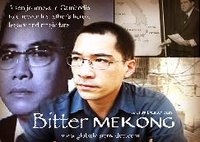 Filmmaker Tiara Delgado will bring her latest documentary, Bitter Mekong, to Phnom Penh for its premiere screening at Meta House on Friday 24 October, to coincide with United Nations Day. Delgado is a prolific filmmaker and this is her fourth documentary on Cambodia. The main subject of Bitter Mekong is Rami Sambath, whose father was Cambodia's Ambassador to the UN and who heeded the call of the Khmer Rouge for overseas Khmers to return to Cambodia, and was never seen again. He perished at Tuol Sleng. The film documents Rami's journey as he looks into his father's heritage and legacy whilst discovering his own identity and sense of belonging at the same time.
Filmmaker Tiara Delgado will bring her latest documentary, Bitter Mekong, to Phnom Penh for its premiere screening at Meta House on Friday 24 October, to coincide with United Nations Day. Delgado is a prolific filmmaker and this is her fourth documentary on Cambodia. The main subject of Bitter Mekong is Rami Sambath, whose father was Cambodia's Ambassador to the UN and who heeded the call of the Khmer Rouge for overseas Khmers to return to Cambodia, and was never seen again. He perished at Tuol Sleng. The film documents Rami's journey as he looks into his father's heritage and legacy whilst discovering his own identity and sense of belonging at the same time.Delgado used her own money to finance her first documentary called Fragile Hopes from the Killing Fields, which she completed in 2003 and which explored the stories behind four survivors and their families, and was narrated by actress Susan Sarandon. Compassion and Controversy was a film about the issues surrounding the adoption of Cambodian orphans, whilst The Road to Closure - Understanding the Khmer Rouge Tribunal brought into focus the desire for justice some thirty years after the nightmare in Cambodia began. It was in 2002 that she set up Global Vision Video which provides production services to educators, activists and non-profit groups seeking to promote their causes on film and video. Make sure you keep the evening of 24 October free, the screening begins at 7pm and Delgado will be there to host the event.
Link: Global Vision Video
The 2nd Environmental & Conservation Film Festival will be held in Cambodia this month, following on from the success of last year's event. It will be hosted on three successive evenings from 16 September at the French Cultural Centre on Street 184 in Phnom Penh. With screenings starting at 6.30pm, each night will present three screenings of a range of documentaries with prizes for the best films. For me the highlights are as follows; 16th: Cambodiana, a 52-minute look at the Cardamom Mountains by Estelle des Dorides; 17th: 32-minute film called Tackling the Challenge, all about global warming from the British FCO; 18th: Forests of the Future, a 26-minute story of groups working together in five Mekong countries to save forests.
Kim gives his all
Oscar Pistorius tramples over notions of equality in Beijing
The four core values of the Paralympic movement are courage, determination, inspiration and equality - by Simon Hart in Beijing for The Telegraph (UK)
It was hard to argue with the first three as Vanna Kim lined up for his 100metres race in the Bird's Nest Stadium. But there was a problem with the fourth. Kim is a 40-year-old Cambodian who, in 1989, had the misfortune to do what more than 40,000 of his countrymen have done since the Khmer Rouge were ousted 29 years ago. He stepped on a landmine and had his right leg torn off below the knee. When you consider that Kim is the only representative in Beijing of a couuntry with one of the highjest percentages of disabled people in the world, the doubts start to creep in about Paralympic equality. But there was another more immediate reason to question the gradient of the playing field as Kim settled into his blocks, wearing a rudimentary running blade that had been donated to him by the South Korean government because he was too poor to pay for one himself. Two lanes away from him was a certain Oscar Pistorius, the South African double-amputee who only just missed out on making his country's Olympic relay team. Attached to his legs were the reason for his famous Blade-Runner nickname: a pair of state-of-the-art J-shaped Cheetah Flex-Foot transibial, carbon-fibre running blades designed by Icelandic company Ossur "to store and release energy in order to mimic the reaction of the anatomical foot/ankle joint of able-bodied runners".
Poor Kim. In a pre-Games interview with a Cambodian newspaper he had described himself as "70 per cent hopeful" of triumphing in Beijing, but his dream disappeared the moment Pistorius' blades jumped out of the blocks and disappeared into the distance, taking him to victory in 11.16sec by a margin of Usain Bolt proportions. Kim, with a limping running gait, was a distant last in 13.45sec. Welcome to the real Paralympic world. No wonder the Cambodian looked bewildered as he wandered alone through the media area beside the track, unable to share his first Paralympic expereince with anyone because nobody spoke Cambodian. Pistorius, on the other hand, was in hot demand by reporters and, ever personable, happy to oblige with his dreams about winning three gold medals in the 100, 200 and 400 metres, and maybe breaking one of his own world records.
Of course, Cheetah blades or not, Kim was never going to challenge an athlete whose achievements have transcended Paralympic sport and who has done more than anyone to raise the profile of disability athletics. But the race proved is that a huge class divide is emerging among Paralympians, both athletic and economic. Kim was only able to make the trip because 60% of his air fare from Cambodia was paid for by the Beijing organisers, with the rest being raised through private donations in his homeland. Pistorius, meanwhile, has been complaining bitterly in Beijing that he and fellow South Africans had to endure economy-class tickets to China while sports officials stretched out and slugged back champagne in business class. He has also been outspoken about the hideous pyjama-style costume that the South African team were supplied with for the opening ceremony and which he and his fellow athletes voted not to wear because the clothing was "something I would be embarrassed to wear in front of millions of people while representing South Africa". If it sounds as if the Blade-Runner has come over all prima donna, the South African government have certainly taken his complaints seriously, ordering a top-level inquiry into the behaviour of team officials. One Freedom Party MP has even described the aeroplane seats fiasco as a "national outrage".
Economy-class tickets? Parade costume? Kim can surely only dream of such luxuries, but he inhabits another world from Pistorius, who has already tasted the big time at some of Europe's top athletics meetings this summer and, cleared to run against able-bodied runners by a court of law, can look forward to plenty of pay days and first-class plane tickets to come as he jets around the world. Kim still has the 200 metres to look forward to before catching his subsidised flight home to Phnom Penh. The snag is that he will have to contend with Pistorius again. With luck, he will have more success with his new career path, coaching disabled athletes in Cambodia. He should have plenty of customers, and plenty to tell them about his own salutary lesson in Beijing.
Note: Kim was given a wildcard into the Paralympics after winning a silver medal in the ASEAN Games in Thailand earlier this year. He has three gold, ten silver and five bronze medals in international competitions under his belt, though the Paralympics is his hardest test on the biggest stage.
Sunday, September 7, 2008
The past & the future
 Better late than never...I forgot to mention that this month there's a focus on architecture in Cambodia, past and present with a series of lectures, exhibitions and publications that will highlight what's been and challenge the local arts community as to what will happen in the future. People like Vann Mollyvann helped shape Cambodia's architectural past with over 100 major public works in the 50s and 60s and many people refer to his work as the pinnacle of the golden era of architecture in modern-day Cambodia. But many of his legacies have already disappeared. So far the latest batch of new buildings springing up around Phnom Penh in particular isn't something that is finding favour with the purists. The month-long Architecture & Urban Design project will include a guided tour with Vann Mollyvann himself, though disappointingly it'll be in French and Khmer, of which I speak neither, as well as lectures at Java Cafe, the French Cultural Centre and Meta House. The exhibitions include In Transit at Meta House from 16th and a look at traditional Khmer wooden architecture with Darryl Collins at Java Cafe on the 22nd.
Better late than never...I forgot to mention that this month there's a focus on architecture in Cambodia, past and present with a series of lectures, exhibitions and publications that will highlight what's been and challenge the local arts community as to what will happen in the future. People like Vann Mollyvann helped shape Cambodia's architectural past with over 100 major public works in the 50s and 60s and many people refer to his work as the pinnacle of the golden era of architecture in modern-day Cambodia. But many of his legacies have already disappeared. So far the latest batch of new buildings springing up around Phnom Penh in particular isn't something that is finding favour with the purists. The month-long Architecture & Urban Design project will include a guided tour with Vann Mollyvann himself, though disappointingly it'll be in French and Khmer, of which I speak neither, as well as lectures at Java Cafe, the French Cultural Centre and Meta House. The exhibitions include In Transit at Meta House from 16th and a look at traditional Khmer wooden architecture with Darryl Collins at Java Cafe on the 22nd.
Behind the walls
Saturday, September 6, 2008
Hush hush
 An unofficial first showing of a brand new story, Hang Yunn, by the students and teachers of the classical dance school of the Secondary School of Fine Arts will take place this Tuesday (9th) at the Chenla Theatre in Phnom Penh at 6pm. Don't tell anyone, but turn up and get in on the night, and it's free. Performances of new classical works are rare but with the fantastic collaboration of Amrita Performing Arts, they are increasing slowly but surely though each work takes many months to prepare and train the dancers before it can be incorporated into the repertoire and performed in public. I haven't managed to find out any details of the Hang Yunn story so I'll be there on Tuesday to see it for myself.
An unofficial first showing of a brand new story, Hang Yunn, by the students and teachers of the classical dance school of the Secondary School of Fine Arts will take place this Tuesday (9th) at the Chenla Theatre in Phnom Penh at 6pm. Don't tell anyone, but turn up and get in on the night, and it's free. Performances of new classical works are rare but with the fantastic collaboration of Amrita Performing Arts, they are increasing slowly but surely though each work takes many months to prepare and train the dancers before it can be incorporated into the repertoire and performed in public. I haven't managed to find out any details of the Hang Yunn story so I'll be there on Tuesday to see it for myself.It's a busy weekend on the football front. Bayon Wanderers, the mish-mash of expats and Khmer players that I joined a couple of months ago, have a game at 2pm today at the Old Stadium and then two more games tomorrow, in the morning and afternoon. Fortunately we now have a large squad of players to select from, and fingers crossed my dodgy groin will hold out, though the dark clouds hovering overhead may put the games in some doubt. The Old Stadium is now run by the Armed Forces and as such they will cancel games at short notice depending on the weather situation. It's understandable as the games are friendlies and there are a dearth of good pitches in and around the capital, so they need to protect their pitch.
Friday, September 5, 2008
Wrap-up for Year Zero
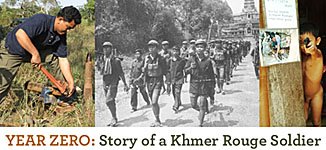 Very close to final edit and wrap-up is the 90-minute film Year Zero: Story of A Khmer Rouge Soldier. Director John Severson has to finalize the film's score with award winning composer Jesper Kyd before submitting the finished article to the Sundance Film Festival in the States before the end of this month. Year Zero is a film about the power of the individual, as the cameras follow the story of a former child soldier, Aki Ra, who, as a very young child of six was drafted into the Khmer Rouge and planted hundreds of landmines for them. It shows how he decided to rebel and to dedicate his life to changing his country's circumstance ever since. Starting from humble beginnings and now as an international symbol of one man's purpose to eradicate landmines, Aki-Ra's Cambodian Land Mine museum has now relocated near Banteay Srei and has changed the lives of tens of thousands of people who visit each year. Find out more here.
Very close to final edit and wrap-up is the 90-minute film Year Zero: Story of A Khmer Rouge Soldier. Director John Severson has to finalize the film's score with award winning composer Jesper Kyd before submitting the finished article to the Sundance Film Festival in the States before the end of this month. Year Zero is a film about the power of the individual, as the cameras follow the story of a former child soldier, Aki Ra, who, as a very young child of six was drafted into the Khmer Rouge and planted hundreds of landmines for them. It shows how he decided to rebel and to dedicate his life to changing his country's circumstance ever since. Starting from humble beginnings and now as an international symbol of one man's purpose to eradicate landmines, Aki-Ra's Cambodian Land Mine museum has now relocated near Banteay Srei and has changed the lives of tens of thousands of people who visit each year. Find out more here.
And there's more...
I liked the sound of WASH day on Wednesday. 1,000 villagers and primary school kids in one of Phnom Penh's 76 commune's focused on the importance of washing hands in order to prevent the spread of disease, with a hand-washing display arranged by USAID. A global Water, Sanitation and Hygiene (WASH) day is set for 15 October (my birthday!) as its the UN's Year of Sanitation this year. This is important - over 2 million children die every year because of diarrhoea - clean hands can save lives.
Wednesday, September 3, 2008
That's all folks!
 This narrow lintel shows Indra (without his elephant) or possibly Shiva, with a partial naga antefix above
This narrow lintel shows Indra (without his elephant) or possibly Shiva, with a partial naga antefix above Making my blood boil
Luckily they didn't knock last night, as I didn't even have the energy to open the door! Yesterday afternoon I got off work a couple of hours early to play football at the Old Stadium for the Bayon Wanderers midweek team against regular opponents Devenco. I am still weeks away from anywhere near proper fitness and I was blowing out of my arse at the final whistle, even though I only played about sixty minutes in two spurts. Up until now I didn't really appreciate the impact that my seven-year lay-off has had on my body. It's got used to not running, not breathing, not stretching, literally not doing anything sporty and its fighting back as I try to get it approaching my former fitness levels. Niggling injuries haven't helped, neither has an irritating chest cough but excuses aside, I have to be realistic and tell myself that I will never regain the speed and agility that I used to possess - well, I would say that wouldn't I. No-one else thought I was fast or agile but I think you get the picture. Oh, and the result, we lost a close-fought game, 2-1.
Cruising the islands
En route to 4,000 Islands
Monday, September 1, 2008
Waterfall haven
Buddha takes a rest
Meta's messages
 On Wednesday this week (3rd) there's a 96 minute drama film dealing with human trafficking and child labour issues in Cambodia from the BBC called In The Dark. It was shown in cinemas and on tv last year. The Messenger Band (pictured) make their Meta House debut on Saturday 13th. Formed by female garment factory workers a couple of years ago, they sing about globalization, sex work and child labour. The Womyn's Agenda for Change initiated the band as a way of getting across their message and it seems to work. There's a slew of other documentaries and films throughout the month on a variety of topics, as well as two exhibitions, Art of Survival until the 12th and then on 16th, a new exhibition opens, In Transit: Phnom Penh's urban spaces. Something for everyone at Meta House.
On Wednesday this week (3rd) there's a 96 minute drama film dealing with human trafficking and child labour issues in Cambodia from the BBC called In The Dark. It was shown in cinemas and on tv last year. The Messenger Band (pictured) make their Meta House debut on Saturday 13th. Formed by female garment factory workers a couple of years ago, they sing about globalization, sex work and child labour. The Womyn's Agenda for Change initiated the band as a way of getting across their message and it seems to work. There's a slew of other documentaries and films throughout the month on a variety of topics, as well as two exhibitions, Art of Survival until the 12th and then on 16th, a new exhibition opens, In Transit: Phnom Penh's urban spaces. Something for everyone at Meta House.
Peace in every step
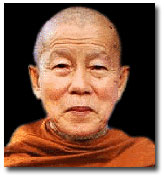 The Bangkok Post posted an article on the late Maha Ghosananda - the Father of Cambodian Buddhism - at the weekend. I think it's worth having a look. Maha Ghosananda died in March 2007, a Nobel Peace Prize-nominated monk who was a major factor in the rebirth of Buddhism in Cambodia after the fall of the Khmer Rouge. He passed away in the US, where he'd been a frequent visitor since the late '80s. Born in 1929 in Takeo, he was elected a Supreme Cambodian Buddhist Patriarch by fellow monks in 1988 for his tireless efforts to revive Buddhism, human rights and for peace. In advocating the latter, he led a series of 'Dhammayietra' peace walks in Cambodia in the '90s and received four Nobel Peace Prize nominations for his efforts. The article, Peace In Every Step, can be viewed here.
The Bangkok Post posted an article on the late Maha Ghosananda - the Father of Cambodian Buddhism - at the weekend. I think it's worth having a look. Maha Ghosananda died in March 2007, a Nobel Peace Prize-nominated monk who was a major factor in the rebirth of Buddhism in Cambodia after the fall of the Khmer Rouge. He passed away in the US, where he'd been a frequent visitor since the late '80s. Born in 1929 in Takeo, he was elected a Supreme Cambodian Buddhist Patriarch by fellow monks in 1988 for his tireless efforts to revive Buddhism, human rights and for peace. In advocating the latter, he led a series of 'Dhammayietra' peace walks in Cambodia in the '90s and received four Nobel Peace Prize nominations for his efforts. The article, Peace In Every Step, can be viewed here.
